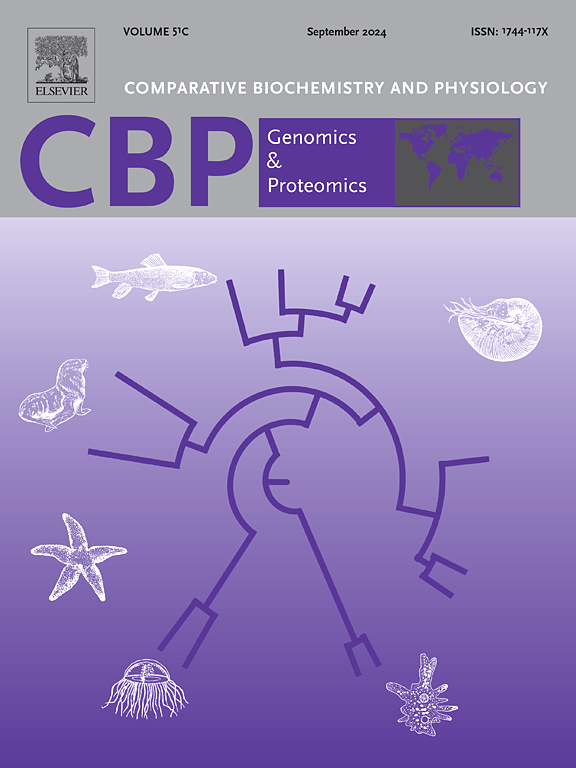Functional verification of a landmark gene EVM713 involved in spermatogenesis in the marine bivalve Chlamys nobilis
IF 2.2
2区 生物学
Q4 BIOCHEMISTRY & MOLECULAR BIOLOGY
Comparative Biochemistry and Physiology D-Genomics & Proteomics
Pub Date : 2025-01-06
DOI:10.1016/j.cbd.2024.101412
引用次数: 0
Abstract
The formation of broodstock gametes is closely linked to the yield and quality in aquaculture production, yet molecular mechanisms underlying this process remain insufficiently understood. The noble scallop Chlamys nobilis, an economically significant dioecious bivalve species, serves as an excellent model for studying gametogenesis. In this study, the adult scallops with testis at different developmental stage were chosen for histological examination and transcriptome analysis to dig genes related gonad development. Totally, 2663 DEGs and their set modules significantly related to spermatogenesis were obtained using WGCNA, including 40 candidate genes represented by EVM713. The gene was specifically expressed in the testis. RNA interference (RNAi) of EVM713 led to impaired testis development, marked by sparse sperm cell arrangement, spermatocytes detaching from the follicle wall, and reduced spermatocyte numbers. Meanwhile, 24 h after RNAi, the expression levels of Bax, and Caspase3 significantly increased (P < 0.05), while those of Bcl2, Dmrt2 and Tssk4 were significantly decreased (P < 0.05). These results indicate that EVM713 is essential for spermatogenesis in bivalves, regulating testis development through the modulation of Dmrt2 and Tssk4 expression. This study provides the first evidence of EVM713 function in mollusks, which is conducive to better understanding molecular mechanisms underlying gametogenesis in marine invertebrates.

海洋双壳类动物Chlamys nobilis精子发生相关的标志性基因EVM713的功能验证。
亲鱼配子的形成与水产养殖产量和质量密切相关,但这一过程背后的分子机制尚不清楚。贵族扇贝(Chlamys nobilis)是一种具有重要经济意义的雌雄异株双壳类物种,是研究配子体发生的良好模型。本研究选取不同发育阶段睾丸的成体扇贝进行组织学检查和转录组分析,挖掘与性腺发育相关的基因。利用WGCNA共获得2663个与精子发生显著相关的deg及其集合模块,其中以EVM713为代表的候选基因有40个。该基因在睾丸中特异性表达。EVM713的RNA干扰(RNAi)导致睾丸发育受损,表现为精子细胞排列稀疏,精母细胞脱离卵泡壁,精母细胞数量减少。同时,RNAi后24 h, Bax、Caspase3的表达水平显著升高(P
本文章由计算机程序翻译,如有差异,请以英文原文为准。
求助全文
约1分钟内获得全文
求助全文
来源期刊
CiteScore
5.10
自引率
3.30%
发文量
69
审稿时长
33 days
期刊介绍:
Comparative Biochemistry & Physiology (CBP) publishes papers in comparative, environmental and evolutionary physiology.
Part D: Genomics and Proteomics (CBPD), focuses on “omics” approaches to physiology, including comparative and functional genomics, metagenomics, transcriptomics, proteomics, metabolomics, and lipidomics. Most studies employ “omics” and/or system biology to test specific hypotheses about molecular and biochemical mechanisms underlying physiological responses to the environment. We encourage papers that address fundamental questions in comparative physiology and biochemistry rather than studies with a focus that is purely technical, methodological or descriptive in nature.

 求助内容:
求助内容: 应助结果提醒方式:
应助结果提醒方式:


